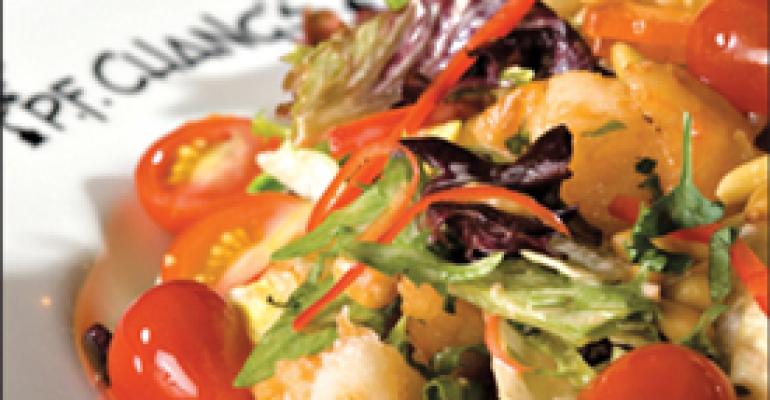The average American now eats more than 4 pounds of shrimp per year. That’s not a lot compared with the consumption of beef or chicken, but it’s an increase of about 60 percent during the past 10 years, according to the U.S. Department of Agriculture.
It’s even a significant jump from the 3.4 pounds eaten on average in 2001, the year that shrimp dethroned tuna as America’s favorite seafood.
Chefs, naturally, are responding to the demand for shrimp with creative new preparations. And this summer, they are taking the form of salads.
“Everybody does shrimp salad with mayonnaise and celery,” says Michael Scott Castell, chef of Bistro Toulouse in Houston. So instead he indulges his own love for tarragon.
“Tarragon is one of my most favorite herbs to use, and outside of foodies, people don’t know what it is,” he says.
He uses the herb to infuse Champagne vinegar, which he uses, along with white wine, to deglaze a pan of sautéed scallion whites. He reduces that, adds heavy cream, reduces it some more and then whips up the sauce with butter.
He sautés peeled and deveined extra-large shrimp in that sauce, which also is the salad’s dressing. He tosses field greens in it, wilting them a little.
He garnishes the shrimp with tomato confit, which he makes by slowly cooking peeled and seeded Romas in olive oil infused with rosemary, tarragon, basil, thyme and garlic. The warm salad is $9.
Castell says the relatively thick sauce invokes the feeling of traditional mayonnaise.
Chefs across Long Island, N.Y., are combining their summertime customers’ love of shrimp and desire for salad with another trend: the bold flavors of Asia.
At The Beacon in Sag Harbor, N.Y., chef Sam McCleland serves a chopped salad of romaine and radicchio with crispy shrimp and peanut-ginger dressing. He makes a dressing of teriyaki, honey, orange and lemon juices, sesame oil, peanut butter, ginger, garlic, rice wine vinegar, and grape seed oil.
He lightly dusts 21-25 count shrimp in flour seasoned with paprika, cayenne pepper, salt and pepper and deep-fries them for about 45 seconds.
“Anyway people can get shrimp, I think they like it,” McCleland says. “This is a very nice, light, summertime salad.”
Not far from The Beacon, in Southampton, N.Y., chef Douglas Gulija of The Plaza Café, marinates shrimp in fish sauce, yuzu juice, scallions, minced lemon grass and chives emulsified with grapeseed oil. He then grills the shrimp and serves it over a salad of shredded Napa cabbage, mango, jícama and fried won ton chips.
Gulija says he serves that salad at receptions in Chinese to-go containers and that it’s a big hit. When he offers it on the menu, it sells for $15 to $18.
At The Gatsby in Islip, N.Y., chef Craig Attwood uses coconut milk, reduced a little with lemon grass and kaffir lime leaf, in his vinaigrette, which also has tamarind paste, sweet soy, fish sauce and lime juice. He finishes the sauce with either chile sauce or chopped Thai chiles and fresh cilantro.
The sauce dresses a salad made of mango and pineapple sliced lengthwise on a mandolin—“almost like a shoestring French fry,” he says,—tossed with watercress and endive.
He blanches the shrimp in a strong court bouillon flavored with lemon grass, lime juice, white wine, coriander seed, pink peppercorns, cardamom, star anise and salt and mixes them in as well. He wraps ribbons of cucumber, also sliced on a mandolin, around the salad.
“The flavors blend well together,” Attwood says.
At Alison at Blue Bell in Blue Bell, Pa., chef Alison Barshak brings Mexican flavors to her shrimp salad, serving it with a salsa fresca of diced white onion, plum tomatoes, Serrano peppers, tomato juice, cilantro, lime juice, black beans and salt. She marinates all of that together and layers it with guacamole and peeled cooked shrimp. She finishes it with a squeeze of lime and a sprig of cilantro for garnish, and serves it with tortilla chips.
“We were serving it in a glass as a Mexican shrimp cocktail, but all the glasses broke, so we put it in a bowl and people liked it better, and they started calling it a salad,” Barshak says. “It’s like the kind of thing I like to snack on at the end of the night. I love shrimp cocktail, and this has a little more personality.”
At the suggestion of a guest, she changed the name from “Mexican” to “Southwestern,” and sales picked up for the salad, $11.50.
Chain restaurants are putting their own twists on shrimp salads, too. Casual-dining giant Applebee’s Grill & Bar recently rolled out the $8.99 California Shrimp Salad as part of its “Grilling Fresh with Tyler Florence” campaign.
For the salad, grilled shrimp is mixed with avocado, bacon, black olives, hard-boiled eggs and grape tomatoes. That’s all tossed with creamy avocado dressing and served on Bibb lettuce.
Applebee’s management says the dish “is a new take on coastal grilling.”
“It’s fresh, colorful and aromatic,” they say.
Scottsdale, Ariz.-based P.F. Chang’s China Bistro offers a shrimp salad for which the crustacean is marinated, battered, wok-fried and tossed with seasonal greens, candied papaya, grape tomatoes, red bell pepper, herbs and pine nuts in a spicy creamy dressing made with spicy Sriracha sauce, $9.
Pei Wei Asian Diner, P.F. Chang’s fast-casual sister chain, had a $7.95 Thai Dynamite Shrimp Salad as a limited-time offer. For that dish sweet soy, Sriracha and fresh lime flavored the shrimp, which was tossed with baby greens, long beans, Japanese cucumbers and Thai basil.




